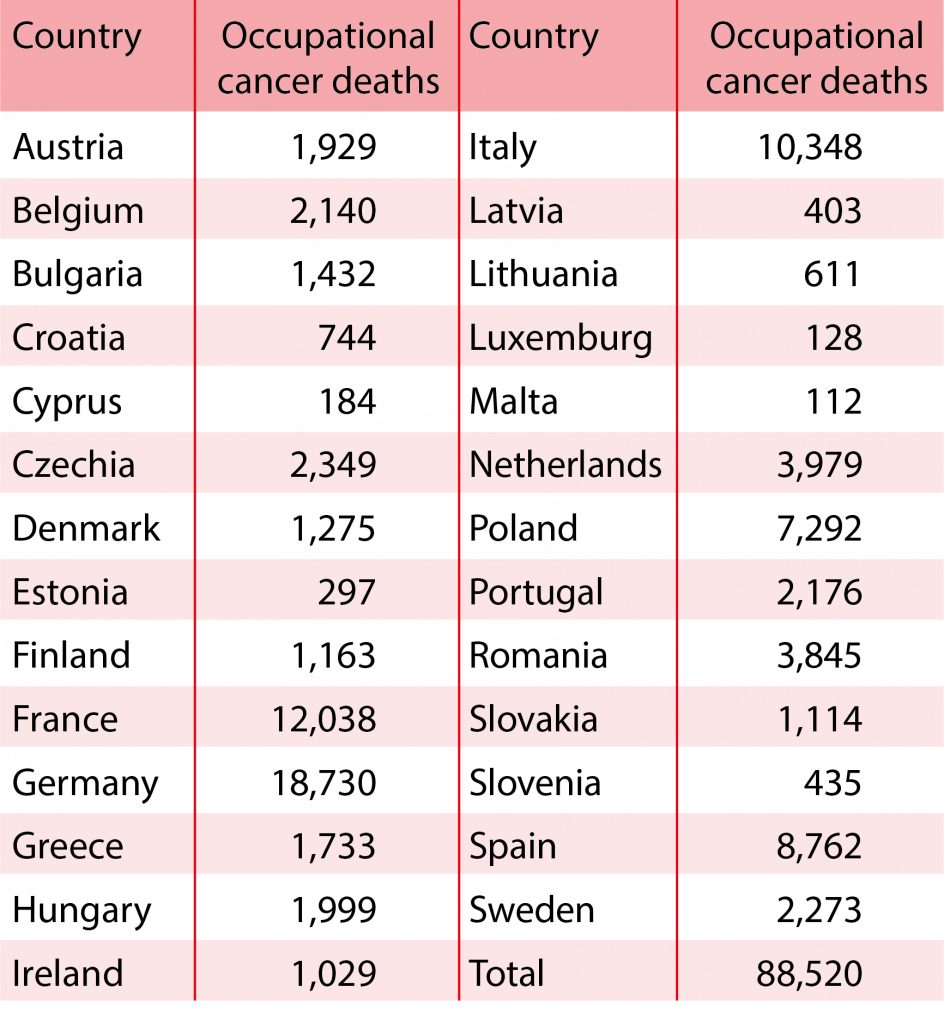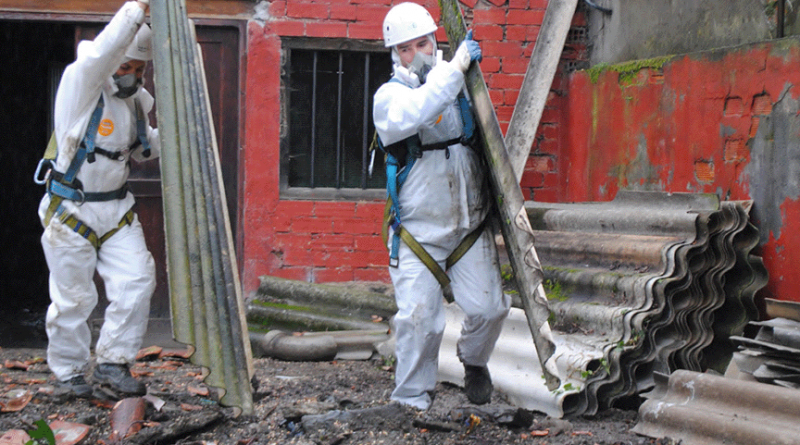Asbestos: a time bomb that needs to be defused
Tony Musu is an ETUI Senior Researcher
Asbestos has been banned in the European Union since 2005, but this carcinogen is still present in millions of buildings across Europe, and it poses a major threat to the health of workers and the population at large. The former are particularly exposed when they work on or in buildings containing asbestos materials, and the risk only increases as these gradually deteriorate.
In the light of the climate crisis, the European Union recently embarked on a huge energy efficiency renovation plan for buildings. If we want to avoid a new wave of victims amongst future generations, the question of asbestos removal must be tackled head-on by European and national authorities.
It has been known for more than 100 years: asbestos is an extremely hazardous substance. Inhalation of asbestos fibres can cause asbestosis and various kinds of cancer, including mesothelioma, lung cancer, cancer of the larynx and ovarian cancer. The risks of contracting these diseases increase with the number of fibres inhaled, and there is no exposure level below which health is not adversely affected.
In most cases, the symptoms develop only after a long period of latency of 20 to 40 years – this is why experts say that asbestos is like a time bomb. The medical community has been aware of the detrimental effects of this substance since the start of the 20th century, when the first cases of asbestos-associated mortality were diagnosed and documented.
Despite this knowledge, asbestos continued to be used, largely because of the scandalous efforts made by the pro-asbestos lobby to downplay the risks associated with exposure and to prevent essential information from being published in scientific literature and in the popular press. Dishonest industrialists know very well that, as long as doubts persist, there will be no pressure from public opinion or legislation that could eat into their profits.
Asbestos use reached its peak after the Second World War, when it was employed in ever-increasing quantities in an ever-growing number of products in industry and construction.
Its low production costs and its sought-after chemical and physical properties (high tensile strength, resistance to high temperatures, and electrical insulation) contributed to the rapid growth in its use in extremely varied applications: thermal insulation (for pipes and boilers); in fire barriers and ceilings; for the electrical insulation of cables; in trains and ships; and for the manufacture of piping, gutters, chimney pipes, ventilation ducts, garden furniture, planters, decorative items, and so on, in asbestos cement.
It is estimated that between two and four million people have died in the EU since WWII after being exposed to asbestos, the great majority of whom were asbestos workers1.
It is estimated that between two and four million people have died in the EU since WWII after being exposed to asbestos, the great majority of whom were asbestos workers
Four waves of victims
A number of epidemiological ‘waves’ of human exposure to asbestos in Europe can be identified (see Figure 1). The first wave consists of miners and asbestos industry workers. The second wave is made up of carpenters, plumbers, electricians, motor mechanics and other people who have worked with asbestos-containing materials.
Figure 1. The four waves of asbestos exposure

Source: Adapted from DOI: 10.3390/ijerph19074031
The third wave comprises all the workers involved in repairs, renovations and asbestos removal. The EU will experience a fourth wave of people exposed to asbestos deteriorating over time in the buildings where, or close to where, they work or live.
Because of the very long period of latency between exposure and appearance of asbestos-related diseases, these various waves overlap. And as the exposure history of most asbestos victims has not been recorded, it is difficult to estimate the number of deaths associated with each wave.
In practice, asbestos production in Europe ended after 1985 thanks to the introduction of the first restrictions in national and European legislation, and so we can judge that the asbestos-related cancers that we are seeing today are probably mainly the result of the more recent third wave of exposure, in combination with the very end of the first wave and the waning of the second.
We are also beginning to see the consequences of the fourth wave of exposure, evidenced by the increasing incidence of mesothelioma (a cancer almost exclusively caused by asbestos exposure) in patients without a history of occupational exposure.
The manufacture, marketing and use of asbestos was completely banned in the EU in 2005, and considerably earlier in some member states, yet the number of deaths from diseases associated with asbestos is not falling. Lung cancer and mesothelioma caused by asbestos continue to kill around 90,000 people each year in the EU (see Table 1), and mortality will go on increasing for at least one or two decades.
Table 1. Occupational cancer deaths due to asbestos, EU27, 2019

Source: Institute of Health Metrics and Evaluation, Global Burden of Disease and Injury, IHME/GBD, The Lancet Oct 2020, https://vizhub.healthdata.org/gbd-compare/.
As a reminder, up to 78% of occupational cancers recognised in the member states are associated with asbestos. Moreover, occupational cancers are avoidable and their cost in the EU amounts to between €270 and €610 billion a year, or 1.8% to 4.1% of the EU’s GDP2.
The EU Green Deal and asbestos: risk or opportunity?
More than 220 million building units were constructed in the EU before the total ban on asbestos came into effect, so a large proportion of the current building stock still contains this carcinogen.
As a result of the climate crisis, the EU has committed itself to ambitious policies to reduce its greenhouse gas emissions. With the adoption of the European Green Deal and the Renovation Wave for Europe strategy, millions of buildings are expected to be overhauled, renovated or demolished. The European Commission’s objective is to double the annual rate of energy efficiency renovations by 2030.
It must be mentioned, though, that in the construction sector alone, there are already between 4.1 and 7.3 million workers exposed to asbestos. This number is set to increase by 4% a year over the next 10 years3.
The construction sector is the third largest sector in the EU, with 10% of its workers being crossborder workers, of which the self-employed make up a large part. The proportion of workers from low-pay countries on temporary postings is very high.
These workers, who are particularly vulnerable to infringements of health and safety standards, are often unaware of the dangers of this lethal fibre and, in most countries, there are no information campaigns, training or essential safety measures for them.
An entire generation of workers – mainly in the construction sector but in others too, such as firefighters and workers involved in waste processing and recycling – along with the general public, through environmental contamination, will therefore be subjected to an increased risk of exposure to asbestos fibres unless the necessary measures are introduced.
To put an end to the third and fourth waves of human exposure to asbestos and to ensure a fair and socially equitable transition in the construction sector, it is a matter of urgency to put a comprehensive strategy and ambitious legislation in place at EU level for the safe removal and disposal of all asbestos.
Amendments to EU legislation
In September 2022, the European Commission published a Communication entitled Working towards an asbestos-free future4 and a proposal to revise the Directive on the protection of workers from the risks related to exposure to asbestos at work5.
The purpose of this revision of the Asbestos at Work Directive is to reduce the occupational exposure limit (OEL), which is a minimum requirement in all member states that has remained unchanged since 2003. It would be reduced from 100,000 fibres/m³ to 10,000 fibres/m³.
This reduction is clearly insufficient to provide proper protection for the health and safety of millions of exposed workers in Europe. The Netherlands adopted a national OEL of 2,000 fibres/m³ back in 20176, and the European Parliament, in a resolution adopted in 2021 and only recently in its report on the review of the Asbestos at Work Directive7, has called for the European limit value for asbestos to be reduced to 1,000 fibres/m³, 100 times lower than the current value. This far stricter limit value is also supported by the European trade unions and health professionals.
However, focusing solely on the limit value is far too narrow an approach to address the enormity of the asbestos challenge. The European Parliament has taken the right track. As well as a more protective OEL, it is proposing other improvements to the text of the Directive: minimum training requirements for workers exposed to asbestos, certification of asbestos removal operators, deletion of the concepts of ‘sporadic exposure’ and ‘low-intensity exposure’ to asbestos – inappropriate for a carcinogen such as this, which has no threshold for adverse effects – and prioritising the removal of asbestos-containing materials rather than the use of alternative techniques that should be prohibited, such as encapsulation or sealing, and which only postpone the safe removal and disposal of asbestos.
Over and above the provisions of the Asbestos at Work Directive, many member states have already adopted other measures that help towards asbestos exposure prevention, such as mandatory screening for the presence of asbestos in buildings and the establishment of public inventories of buildings that contain it.
In its Communication Working towards an asbestos-free future, the European Commission announced a similar legislative initiative at Community level to improve available information on existing buildings still containing asbestos and asked member states to prepare national asbestos removal strategies.
It also anticipated introducing measures for improving the diagnosis and treatment of diseases caused by asbestos and safer management of asbestos waste. Lastly, it proposed major funding for member states to help them carry out all these measures.
The EU has the opportunity to defuse the asbestos time bomb once and for all. If it does not seize this chance now and leverage the potential synergies offered by the Green Deal, the Renovation Wave and the Recovery Plan for Europe (Next Generation EU), the deathly legacy of asbestos will be passed on to the next generations.
Endnotes
1. ETUI estimates.
2. https://www.etui.org/publications/reports/the-cost-of-occupational-cancer-in-the-eu-28.
3. Lassen C et al (2021) Study on collecting information on substances with the view to analyse health, socio-economic and environmental impacts in connection with possible amendments of Directive 98/24/EC (Chemical Agents) and Directive 2009/148/EC (Asbestos): final report for asbestos, Publications Office. https://data.europa.eu/doi/10.2767/981554.
4. EUR-Lex – 52022DC0488 – EN – EUR-Lex (europa.eu).
5. COM (2022) 489 final of 28 September 2022.
6. See the article by Pien Heuts in HesaMag #27 – Spring 2023.
7. https://www.europarl.europa.eu/doceo/document/A-9-2023-0160_EN.html.
This article was originally published in HesaMag #27 – Spring 2023.




